The Violet-crowned Hummingbird (Ramosomyia violiceps) stands as a jewel among avian wonders, captivating observers with its dazzling plumage and unique characteristics.
This enchanting species, belonging to the Trochilidae family, graces the skies of the southwestern United States and parts of Mexico with its vibrant presence.
Renowned for its striking violet crown that adorns its head, the medium-sized Violet-crowned Hummingbird holds a special place in the world of hummingbirds.
Its adaptability to arid and semi-arid habitats, coupled with its proficiency in hovering flight, makes it a remarkable and agile forager for nectar.
Nestled within the order Apodiformes, this bird showcases intricate courtship rituals and nest-building behaviors.
As stewards of delicate ecosystems, understanding the Violet-crowned Hummingbird’s unique biology unveils the intricate tapestry of nature, where beauty and functionality seamlessly converge in this tiny, aerial marvel. Stay focused.
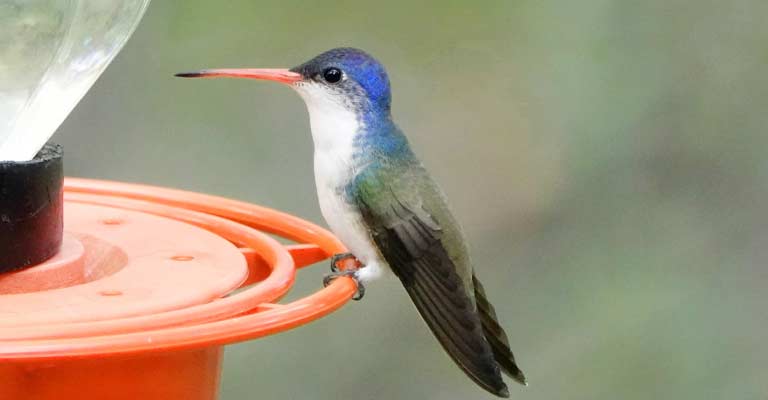
Identifying Characteristics of Violet-crowned Hummingbird
The Violet-crowned Hummingbird (Amazilia violiceps) is a stunning and distinctive bird species known for its vibrant plumage and unique features.
Identifying this particular hummingbird involves paying attention to specific characteristics that set it apart from other species.
Here are eight key points to help you confidently identify the Violet-crowned Hummingbird:
Distinctive Violet Crown
One of the most obvious features of this hummingbird is its striking violet crown, which gives the bird its name.
The vibrant violet coloration extends from the bird’s forehead to the back of its head, creating a distinct and eye-catching crown.
This distinguishing feature sets the Violet-crowned Hummingbird apart from other hummingbird species.
Green Upperparts
The upperparts of the Violet-crowned Hummingbird are primarily green, creating a beautiful contrast with its violet crown.
The green feathers cover the back and wings, providing a visually appealing backdrop to the bird’s colorful head. The combination of violet and green makes this species easily recognizable.
White Throat and Underparts
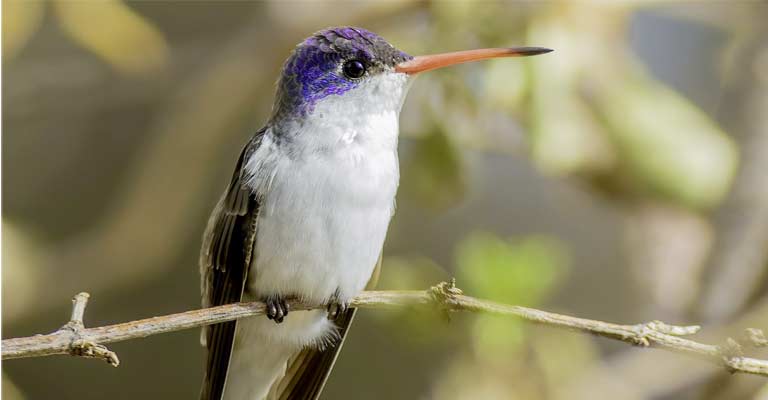
In contrast to the colorful upperparts, the throat and underparts of the Violet-crowned Hummingbird are white. This creates a sharp demarcation between the vibrant crown and the rest of the bird’s body.
The white throat is a distinguishing feature that aids in the identification of this species.
Long, Straight Bill
The Violet-crowned Hummingbird possesses a relatively long and straight bill compared to other hummingbirds.
The bill is adapted for feeding on nectar from flowers, and its distinct shape can help differentiate it from similar-looking species.
Medium Size
In terms of size, the Violet-crowned Hummingbird is considered medium-sized among hummingbirds. Its length typically ranges from 3 to 4 inches (7.5 to 10 centimeters).
This size characteristic, combined with its unique coloration, aids in its identification.
Forked Tail
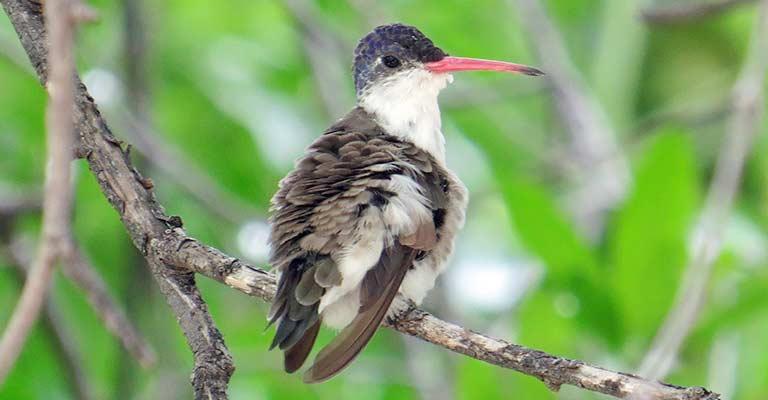
The tail of the Violet-crowned Hummingbird is forked, with two elongated feathers extending beyond the others.
This tail shape is a notable feature and can be observed during flight or when the bird is perched. The forked tail sets it apart from hummingbirds with different tail configurations.
Distinctive Vocalizations
Identifying the Violet-crowned Hummingbird also involves paying attention to its vocalizations.
While visually distinctive, these birds may also produce unique chirps, trills, or other sounds that can help confirm their presence in an area.
Preferred Habitat
Understanding the habitat preferences of the Violet-crowned Hummingbird can aid in identification.
These birds are commonly found in arid and semi-arid regions, including deserts, scrublands, and open woodlands. Observing their habitat can provide additional context for identification.
The Violet-crowned Hummingbird can be identified by its vibrant violet crown, green upperparts, white throat, long straight bill, medium size, forked tail, distinctive vocalizations, and habitat preferences.
These combined features make it a unique and easily recognizable member of the hummingbird family.
Taxonomy of Violet-crowned Hummingbird
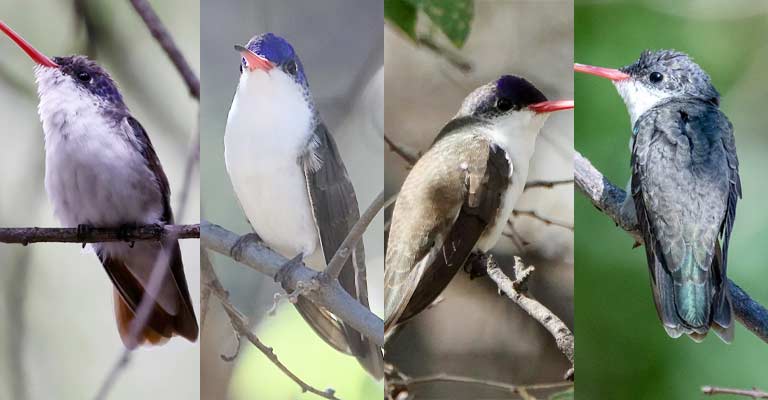
Here’s a table summarizing the taxonomy details of the Violet-crowned Hummingbird:
| Taxonomic Level | Classification |
| Domain | Eukaryota |
| Kingdom | Animalia |
| Phylum | Chordata |
| Class | Aves |
| Clade | Strisores |
| Order | Apodiformes |
| Family | Trochilidae |
| Genus | Ramosomyia |
| Species | R. violiceps |
This table outlines the hierarchical classification of the Violet-crowned Hummingbird within the broader taxonomic framework.
From the overarching domain to the specific species, each level provides insight into the bird’s evolutionary relationships and its place in the tree of life.
The Violet-crowned Hummingbird (Ramosomyia violiceps) exhibits two distinct subspecies, each contributing to the remarkable diversity within this species. The subspecies are the nominate R. v. violiceps and R. v. ellioti.
- Ramosomyia violiceps violiceps (Nominate Subspecies): The nominate subspecies is primarily found in the southwestern United States and northern Mexico. It shares the iconic violet crown and vibrant plumage characteristic of the species. These hummingbirds contribute to the avian biodiversity of arid regions, displaying adaptability to diverse habitats.
- Ramosomyia violiceps ellioti: This subspecies inhabits areas in southern Mexico and extends into Central America. While retaining the essential features of the species, R. v. ellioti may exhibit subtle variations in coloration and morphology. These differences can be attributed to the geographic separation and environmental factors shaping the characteristics of this subspecies.
The existence of these two subspecies emphasizes the dynamic nature of evolutionary processes and the impact of geographical variation on the expression of traits within a single species.
Studying the nuances of each subspecies contributes to a comprehensive understanding of the Violet-crowned Hummingbird’s biology, ecology, and adaptation strategies across its range.
Violet-crowned Hummingbird Life History
The Violet-crowned Hummingbird (Amazilia violiceps) enchants observers not only with its captivating plumage but also with its fascinating life history.
This diminutive hummingbird, endemic to the southwestern United States and parts of Mexico, exhibits a life cycle intricately woven into the tapestry of its diverse habitats.
From its dietary preferences and nesting behaviors to its breeding habits and conservation status, exploring the life history of the Violet-crowned Hummingbird provides a deeper understanding of this remarkable species.
Food
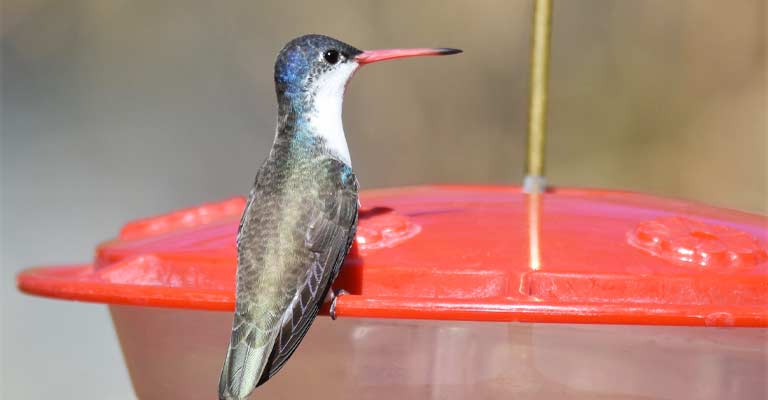
The primary diet of the Violet-crowned Hummingbird consists of nectar obtained from a variety of flowering plants.
With their specialized long, straight bills, they feed by inserting their bills deep into tubular flowers, extracting the nectar with their extendable, tube-like tongues.
Additionally, these hummingbirds supplement their diet with small insects and spiders, providing essential proteins and nutrients.
Their remarkable agility and hovering ability make them adept at reaching the nectar within intricate floral structures.
Habitat
The Violet-crowned Hummingbird displays a versatile habitat selection, thriving in arid and semi-arid environments. These include desert landscapes, scrublands, open woodlands, and even gardens.
Their adaptability to diverse habitats allows them to navigate through a range of ecosystems, provided there are suitable nectar sources and perching spots.
Range Map
The species’ range spans from the southwestern United States, including parts of Arizona and New Mexico, down through Mexico and into Central America.
A detailed range map illustrates their distribution, with sightings concentrated around blooming vegetation and suitable foraging areas.
Nesting and Breeding
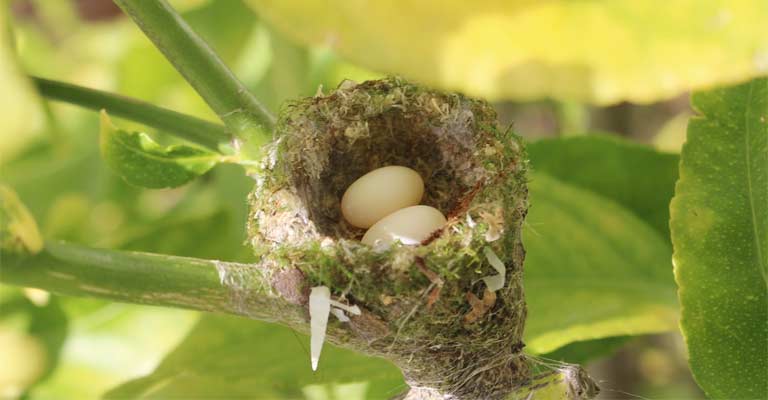
Violet-crowned Hummingbirds are meticulous in their nesting behaviors. Females construct cup-shaped nests using plant fibers, spider silk, and downy materials, often camouflaging them with lichen.
These nests are typically situated on horizontal branches, offering stability for their delicate structures.
Breeding season varies across their range, with courtship displays involving aerial acrobatics and vivid plumage exhibitions.
After successful mating, the female is solely responsible for incubating the two eggs and caring for the offspring upon hatching.
Here’s a table summarizing the nesting details of the Violet-crowned Hummingbird:
| Nesting Details | Facts |
| Clutch Size | Typically 2 eggs |
| Number of Broods | Usually 1 per breeding season |
| Egg Length | Approximately 1.0 cm (0.4 inches) |
| Egg Width | Around 0.6 cm (0.2 inches) |
| Incubation Period | Approximately 15-18 days |
| Nestling Period | About 20-24 days |
| Egg Description | White or creamy, elongated oval shape, often with subtle speckles or markings |
| Nest Structure | Cup-shaped, constructed with plant fibers, spider silk, and downy materials |
| Nest Placement | Positioned on horizontal branches, often camouflaged with lichen or other materials |
| Incubation and Parental Care | The female incubates the eggs and cares for the nestlings; the male may assist with territorial defense |
| Fledgling Independence | Young hummingbirds become independent after the nestling period, but parental care may continue for a brief period |
| Nest Reuse | Violet-crowned Hummingbirds may reuse nests from previous seasons, refurbishing and reinforcing them as needed |
These nesting details provide insights into the reproductive behaviors and parental care exhibited by the Violet-crowned Hummingbird during the breeding season.
Diseases and Treatment
Like many bird species, the Violet-crowned Hummingbird is susceptible to diseases, including avian pox and parasitic infections.
Monitoring their health is crucial, especially during periods of stress or environmental changes.
Veterinarians and ornithologists may implement treatments such as antibiotics or antiparasitic medications to mitigate the impact of these diseases on individual birds or populations.
Conservation
While the Violet-crowned Hummingbird is not currently considered globally threatened, its conservation status varies across its range.
Habitat loss due to urbanization and agriculture poses a significant threat, emphasizing the importance of preserving their natural environments.
Conservation efforts often focus on habitat restoration, educational initiatives, and monitoring population trends to ensure the long-term survival of this enchanting species.
Understanding the intricacies of the Violet-crowned Hummingbird’s life history underscores the importance of maintaining ecological balance and preserving the habitats that sustain this captivating species.
From foraging on nectar to nesting in the arid landscapes, these hummingbirds contribute to the biodiversity of their ecosystems, making them a vital component of the natural world.
10 Fun Facts About Violet-crowned Hummingbird
The Violet-crowned Hummingbird (Amazilia violiceps) is a fascinating and enchanting species that captivates bird enthusiasts with its vibrant appearance and unique behaviors.
Here are 10 fun facts about these delightful hummingbirds:
- Vibrant Crown: As the name suggests, the Violet-crowned Hummingbird boasts a spectacular violet crown on its head, adding a burst of color to its appearance. This distinguishing feature makes it easily recognizable among hummingbird species.
- Size Matters: Despite their tiny stature, these hummingbirds are considered medium-sized in comparison to other members of their family, measuring between 3 to 4 inches in length.
- Versatile Habitat: The Violet-crowned Hummingbird showcases adaptability by thriving in a range of habitats. From arid deserts to open woodlands, these birds can be found navigating diverse ecosystems in the southwestern United States and Mexico.
- Forked Tail Elegance: In flight, their forked tails create a graceful silhouette. This distinct tail shape sets them apart from other hummingbirds and adds to their charm as they hover and dart between flowers.
- Floral Gourmands: Their primary diet consists of nectar obtained from various flowering plants. With their long bills and specialized tongues, they expertly extract nectar from tubular flowers. In addition to nectar, they supplement their diet with small insects and spiders for essential proteins.
- Courtship Rituals: During the breeding season, male Violet-crowned Hummingbirds engage in elaborate courtship displays, showcasing their aerial acrobatics and vibrant plumage to attract potential mates.
- Tiny Eggs: The female typically lays two tiny eggs, each measuring around 1 cm in length. These delicate eggs are incubated for approximately 15 to 18 days before hatching.
- Nest Camouflage: Nest-building is an intricate process, with females crafting cup-shaped nests using plant fibers and spider silk. The nests are often camouflaged with lichen, blending seamlessly into their surroundings.
- Aerial Experts: Violet-crowned Hummingbirds are agile flyers, capable of rapid maneuvers and hovering in mid-air. Their exceptional flying skills enable them to access nectar from even the most intricate floral structures.
- Conservation Concerns: While not globally threatened, habitat loss poses a significant risk to these hummingbirds. Conservation efforts focus on preserving their natural habitats, emphasizing the importance of maintaining ecological balance.
These 10 fun facts provide a glimpse into the captivating world of the Violet-crowned Hummingbird, showcasing not only their aesthetic appeal but also their unique behaviors that make them a true marvel of the avian world.
Wrapping Up
The Violet-crowned Hummingbird stands as a testament to nature’s artistry, blending vibrant plumage with remarkable behaviors.
From their dazzling courtship displays to the delicate intricacies of nest-building, these medium-sized marvels enrich our understanding of avian life.
As stewards of their habitats, it becomes our responsibility to appreciate and safeguard the delicate balance that sustains these enchanting hummingbirds. Thank you so much.